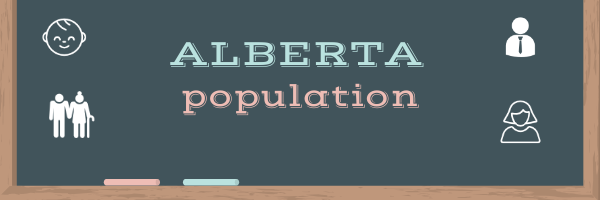
Alberta is the 4th most populated province in Canada with population over 4.5 million people. Alberta’s population account for 11.57 percent of the country’s population. It is home to 4th and 5th most populated city in Canada, Calgary and Edmonton. Alberta’s capital city is Edmonton which is also one of the top 10 biggest city in Canada. Alberta is one of the thirteen providences in Canada located in west side of Canada with area size of 640,081 km2.
Based on our research, Alberta population will reach 4,775,919 (around 4.7 million) by the end of 2024.The calculation is based on the average growth rate of 2.10% over last 12 years since 2011. We believe using the recent years’ figures (see the table in next section) will make the estimation more accurate. The estimation will adjust once Statistic Canada publishes census data.
Population Growth of Alberta
Looking back last twelve years of Alberta’s population, the growth rate is very consistent and strong ranging from 1.93% to 2.31%, adding around 83,349 to 89,058 people each year to the overall population. Lot of workers was moving to Alberta to take advantage of employment opportunities there, which contributes to the population growth. On the other hand, Alberta is a very popular city for immigrants. Alberta has recorded the strongest population growth in 2012 (2.31%).
Between census year of 2011 and 2016, Alberta’s population has increased 421,918 people or 11.57%. That is the second highest growth rate after Nunavut.
| Year | Population | Growth Rate |
| 2011 | 3,645,257 | n/a |
| 2012 | 3,729,640 | 2.31% |
| 2013 | 3,814,337 | 2.27% |
| 2014 | 3,897,686 | 2.19% |
| 2015 | 3,982,698 | 2.18% |
| 2016 | 4,067,175 | 2.12% |
| 2017 | 4,151,108 | 2.06% |
| 2018 | 4,236,325 | 2.05% |
| 2019 | 4,323,247 | 2.14% |
| 2020 | 4,412,305 | 2.06% |
| 2021 | 4,500,803 | 2.01% |
| 2022 | 4,588,903 | 1.96% |
| 2023 | 4,677,690 | 1.93% |
Demographics of Alberta
According to Canada census, Alberta is an extremely diverse city, with a huge number of ethnic and cultural groups living there. According to 2016 census, most commonly ethnic origins include: English (27.2%), German (20.9%), Canadian (20.5%), Scottish (20.3%), Irish (16.6%), French (11.9%), Ukrainian (10.2%), Dutch (5.3%), Polish (5.2%), North American Indian (5.2%), Norwegian (4.4%) and Chinese (4.2%).
In terms of language, according 2016 census, most spoken languages in Alberta are as follows: Chinese (3.02%) is the mothe spoken non official language,followed by German(2.62%), French(1.90%).Other mother tongues include: Punjabi, with 36,320 native speakers (1.13%); Tagalog, with 29,740 (0.92%); Ukrainian, with 29,455 (0.91%); Spanish, with 29,125 (0.90%); Polish, with 21,990 (0.68%); Arabic, with 20,495 (0.64%); Dutch, with 19,980 (0.62%); and Vietnamese, with 19,350 (0.60%). The most common aboriginal language is Cree 17,215 (0.53%).
Other common mother tongues include Italian(0.41%); Urdu(0.35%); and Korean(0.33%); then Hindi(0.28%); Farsi(0.24%); Portuguese(0.22%); and Hungarian(0.21%).
According 2001 census date, the religious makeup of Alberta is: Christian(40.90%), No religious affiliation(31.60%), Sikh(1.50%), Buddhist(1.20%), Muslim(3.20%), Hindu(1.0%).
Population Density of Alberta
Alberta’s population density is 6.35 people per kilo square meter.
Most Populated Cities in Alberta
Based on 2016 Cesus data, here are the most populated cities in Alberta. Canadian Statistics classify them as population are which requires population greater than 1,000 and population density not less than 400 people per square km2. Montreal is by far has the most population compared with other cities in Alberta.
| Rank | City | 2016 Census |
| 1 | Calgary | 1,237,656 |
| 2 | Edmonton | 1,062,643 |
| 3 | Red Deer | 99,718 |
| 4 | Lethbridge | 87,572 |
| 5 | Fort McMurray | 66,573 |
| 6 | Medicine Hat | 62,935 |
| 7 | Grande Prairie | 62,320 |
| 8 | Airdrie | 61,082 |
| 9 | Spruce Grove | 36,125 |
| 10 | Lloydminster (Alberta/Saskatchewan) | 31,400 |
| 11 | Leduc | 29,556 |
| 12 | Okotoks | 28,833 |
| 13 | Cochrane | 25,289 |
| 14 | Fort Saskatchewan | 23,895 |
| 15 | Chestermere | 19,472 |
| 16 | Camrose | 18,520 |
| 17 | Beaumont | 17,396 |
| 18 | Stony Plain | 16,271 |
| 19 | Sylvan Lake | 14,942 |
| 20 | Brooks | 14,436 |
Facts About Aberta
- Alberta was named after Princess Louise Caroline Alberta (1848–1939), the fourth daughter of Queen Victoria.
- In 2016, Alberta reported the youngest population in the provinces with an average age of 36.7 years, relative to a nationwide average of 41.2 years.
- Alberta has a tropical climate and more sunlight than any other region in Canada.
- Alberta employees had the largest gross weekly wages ($1,108.01) in 2013 – 22% over the national average.
- The biggest beaver dam known to exist is the Wood Buffalo National Park in Alberta, Canada, with a total of 2,790 feet (850 m).
- Alberta is the only rat free zone in North America with millions spent every year for very sophisticated monitoring and trapping system to keep the rats out of the Province!
- Alberta is Canada’s sixth-largest province (by area), located between west British Columbia and east Saskatchewan.
- Alberta has experienced a strong growth rate since the year 2000, largely attributed to a booming economy, as well as young people relocating from other provinces.
References
The following links provide data for this topic:
- Statistics Canada: https://www12.statcan.gc.ca
- Government of Alberta: https://www2.gov.bc.ca
